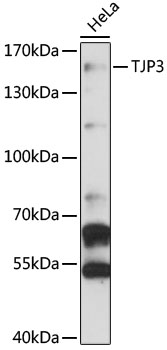-
Product Name
TJP3 Polyclonal Antibody
- Documents
-
Description
Polyclonal antibody to TJP3
-
Tested applications
WB, IF
-
Species reactivity
Human
-
Alternative names
TJP3 antibody; ZO-3 antibody; ZO3 antibody; tight junction protein 3 antibody
-
Isotype
Rabbit IgG
-
Preparation
Antigen: Recombinant fusion protein containing a sequence corresponding to amino acids 710-919 of human TJP3 (NP_001254489.1).
-
Clonality
Polyclonal
-
Formulation
PBS with 0.02% sodium azide, 50% glycerol, pH7.3.
-
Storage instructions
Store at -20℃. Avoid freeze / thaw cycles.
-
Applications
WB 1:500 - 1:2000
IF 1:50 - 1:100 -
Validations

Western blot - TJP3 Polyclonal Antibody
Western blot analysis of extracts of various cell lines, using TJP3 antibody at 1:3000 dilution.Secondary antibody: HRP Goat Anti-Rabbit IgG (H+L) at 1:10000 dilution.Lysates/proteins: 25ug per lane.Blocking buffer: 3% nonfat dry milk in TBST.Detection: ECL Basic Kit .Exposure time: 90s.
-
Background
TJP1, TJP2, and TJP3 are closely related scaffolding proteins that link tight junction (TJ) transmembrane proteins such as claudins, junctional adhesion molecules, and occludin to the actin cytoskeleton. The tight junction acts to limit movement of substances through the paracellular space and as a boundary between the compositionally distinct apical and basolateral plasma membrane domains of epithelial and endothelial cells. Binds and recruits PATJ to tight junctions where it connects and stabilizes apical and lateral components of tight junctions. Promotes cell-cycle progression through the sequestration of cyclin D1 (CCND1) at tight junctions during mitosis which prevents CCND1 degradation during M-phase and enables S-phase transition. With TJP1 and TJP2, participates to the junctional retention and stability of the transcription factor DBPA, but is not involved in its shuttling to the nucleus (By similarity). Contrary to TJP2, TJP3 is dispensable for individual viability, embryonic development, epithelial differentiation, and the establishment of TJs, at least in the laboratory environment (By similarity).
Related Products / Services
Please note: All products are "FOR RESEARCH USE ONLY AND ARE NOT INTENDED FOR DIAGNOSTIC OR THERAPEUTIC USE"
